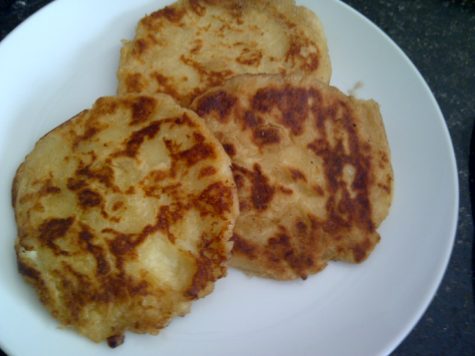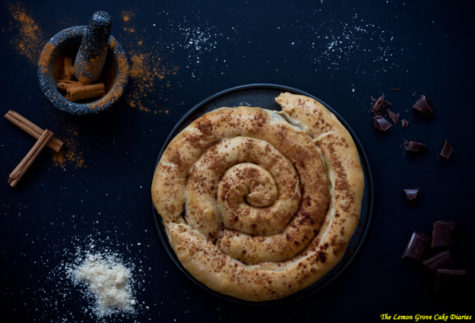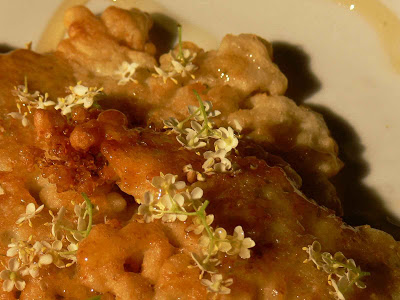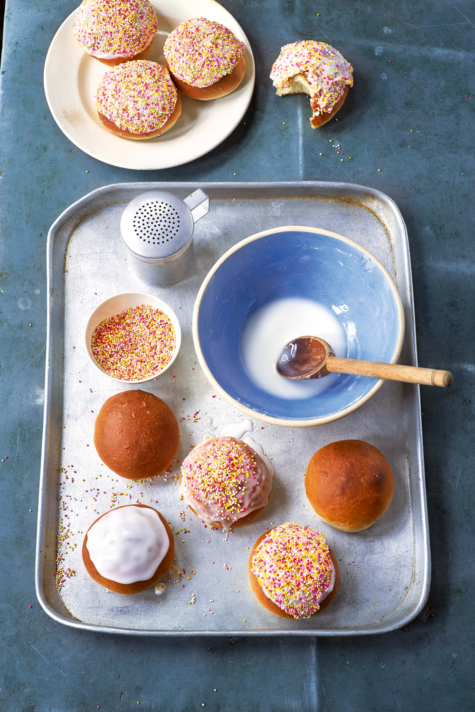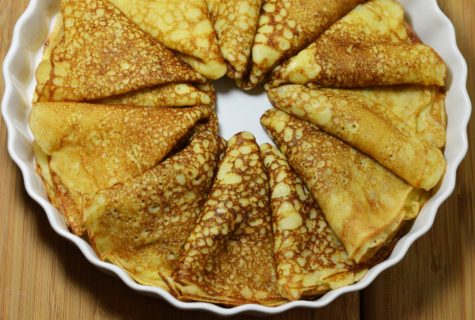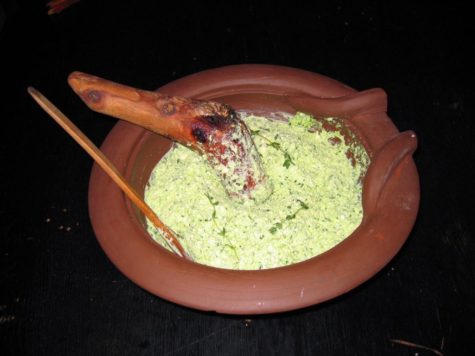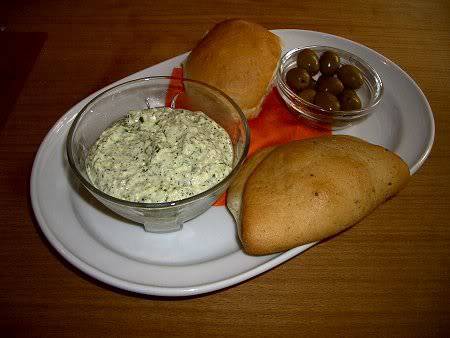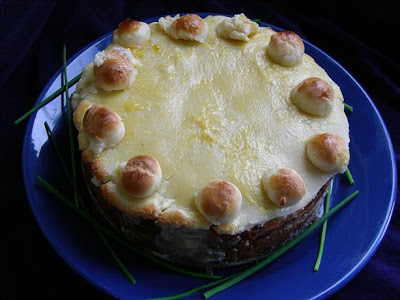Seasonal Recipes
- 2-1/2 gallons water
- 1 cup meadowsweet herb
- 1 cup woodruff sprigs
- 1 cup heather flowers
- 3 cloves
- 1 cup honey
- 1/4 cup brown sugar
- 1 cup barley malt
- 1 oz. brewer’s yeast
Pour the water into a large cauldron or kettle. Bring to a boil and add the meadowsweet herb, woodruff sprigs, heather flowers, and cloves. Boil for one hour and the add the honey, brown sugar, and barley malt. Stir thirteen times in a clockwise direction and then remove from heat.
Strain through a cheesecloth and allow the mead to cool to room temperature. Stir in the brewer’s yeast. Cover with a clean towel and let it stand for one day and one night. Strain again, bottle, and then store in a cool place until ready to serve.
Midsummer Ritual Mead is an ideal drink to serve at Summer Solstice Sabbats, as well as during all Cakes and Ale Ceremonies and Esbats.
From: The Wicca Spellbook
Oats and oat cakes are still used today in Beltane celebrations, especially in Scotland where the tradition originated. Therefore, oats have been widely accepted as a very appropriate Beltane food, good for fertility and luck. This recipe for Farls, was popular in northern Ireland and Scotland, incorporating the ever-popular potatoes as well (with the oats!). Best of all, it’s gluten free!
Ingredients:
- 3 cups real mashed potatoes
- 2 cups dry oats
- 2 tablespoons butter or margarine
- 1/2 teaspoon cornstarch
- 1/2 teaspoon baking powder
- 1/8 teaspoon salt
- Pinch of pepper
- Pinch of rosemary (optional)
Directions:
Soak the oats in warm water for 15 to 20 minutes. (Use the amount of water your oats package tells you to use as if for cooking.) Drain the oats if there is extra water at the end of their soaking, then mix the potatoes and other ingredients into the bowl. Knead it together until a dough forms. If it’s still too moist, add flour until it can be picked up and shaped. Form into round patties. Fry in hot vegetable oil until lightly browned and serve immediately.
NOTE:
They seem to cook best if you put them in the pan and don’t smush them down with the spatula on their first side. When you flip them over, that’s when you can smush them down a little, because they’ve got a cooked surface that won’t get stuck to your spatula.
Yield: 8 servings
Source: Sabbats
The serpent or snake is a symbol of May because of its ancient association with fertility. This association dates back to the earliest Pagan religions, and though later religions cropped up casting the serpent in a deceitful role, the Earth religions still honor the snake as a blessed creature this time of year. Its way of slithering along the body of the Earth made it an obvious phallic symbol, and May Day is full of such symbols (the maypole being the most well-known one).
The holiday of Beltane comes on the first of May and encourages those who celebrate life to greet spring’s bounty with festivities, and that of course always involves food. This snake-shaped cake, incorporating appropriate seasonal ingredients, is a wonderful addition to a party table.
Ingredients:
- 3/4 cup sugar
- 1/2 teaspoon ground cloves
- 1 1/2 teaspoons ground nutmeg
- The zest of one orange
- 1 teaspoon baking soda
- 3/4 teaspoon salt
- 4 1/2 cups plus 2 tablespoons flour
- 1/2 cup butter
- 3/4 cup plus 3 tablespoons honey, boiling
- 1/2 cup strong espresso coffee
- 1 egg
- 1/3 cup amaretto or rum
- /3 cup wild cherry or raspberry jam
- Garnish: 4 coffee beans and some candied orange peel, in slices
Directions:
Preheat the oven to 400º F. Mix the sugar, spices, zest, soda, and salt into the flour in a bowl. Cut in the butter until little pebbles form. Pour in the honey, coffee, and liqueur, and mix in the egg. Mix the batter until everything is evenly distributed and you have a nice soft dough. Let it cool.
Turn it out onto a floured surface and divide in half. Roll one half into an 18-inch rope. Make a deep trough down the center and fill it with jam. Seal it by bringing the edges up over the jam and pressing the seam together. Then flip it seam-side-down onto a parchment-paper-covered baking sheet. Arrange the snake in a circle, but don’t press the ends together. Make one end tapered like the end of a snake’s tail, and make the other end triangular like a snake’s head.
Press in coffee beans for eyes and orange rind for scales if desired. Repeat this process with the other half of the dough and bake them for 30 minutes.
Yield: 2 snake cakes.
Source: Beltane, by Grimassi
This is a very crusty and somewhat dry bread that is incredibly delicious and almost pastry-like in its sweetness. It is ideal for May Day/Beltane celebrations.
Ingredients:
- 1 envelope active dry yeast
- 1/3 cup real maple syrup
- ¼ cup warm water (105ºF-115ºF)
- 3 cups flour
- 3 tablespoons packed brown sugar
- 1 tablespoon baking powder
- ½ teaspoon salt
- ¼ cup shortening
Directions:
Dissolve yeast in the water. Mix 1 ½ cups of the flour with the brown sugar, baking powder, and salt. Cut in shortening. Dissolve the syrup into the yeast mix too. Add yeast mix to the flour mix; stir. Add flour until dough is easy to handle. Turn onto a floured surface and knead for 1 minute. Cover and let rise for 15 minutes. Form into round, place on cookie sheet. Let rise in a warm spot for 30 minutes.
Preheat oven to 350ºF. Slice pleasing image into bread top. Bake for 30 minutes. Bread is done when it sounds hollow when tapped. Loaf can be brushed with syrup or butter during last 5 minutes of baking.
NOTE: Your bread will have trouble rising if the syrup is too cold! Warm up the syrup if it has been in the refrigerator, it should be room temperature or warmer.
Yield: 1 loaf
Source: A Kitchen Witch’s Cookbook
Fritters are a nice variation on pancakes, and the bonus for this particular recipe is that they are sweet without any additions, requiring no syrup, sugar or jam. Many people have had fritters of various types, especially the popular apple variety. But . . . “elder flower” fritters? Yes, these actually contain elder flowers!
Flowers were a common ingredient in cooking during medieval times, which is where this recipe comes from (England, specifically). In this recipe’s case, the flowers mixed into the batter help add a kick and a minty taste.
Because of the elder flowers, these sweeties have been associated with faeries in folk myths. Because of that, they have been used at Pagan celebrations of Beltane, Litha, and Lughnasadh to help as a protection against the malevolent and mischievous fair folk, and sometimes these are even made at Samhain season as a symbol of keeping away bad spirits.
If you’ve never made a recipe incorporating flowers before, you might start with this one–you’ll be pleasantly surprised! (Read on after the directions for variations and notes.)
Ingredients:
- 1 egg
- 1 teaspoon rose water
- 1/2 cup honey
- 2 tablespoons brandy
- 1 cup self-rising flour
- 1/4 teaspoon cinnamon
- 2 cups elder flowers, freshly picked and cleaned
Directions:
Mix egg, rose water, honey, and brandy in a bowl, then stir in flour and cinnamon. Should be thick like pancake batter. (Add flour if it’s too thin, and add more brandy if it’s too thick.) Fold in the flowers. Fry like pancakes, OR drop by the teaspoonful into a deep-fat fryer until golden brown. Serve with orange water sprinkle and fresh lemon, or dip in sweet cream.
Yield: Fried like pancakes: About 10. Deep fat fryer: About 2 dozen.
Use for: Beltane, Litha, Lughnasadh, Samhain, The Floralia
Source: A Kitchen Witch’s Cookbook
Note: In many areas it may be tough to find fresh elder flowers. If you order from somewhere or pick them yourself, make sure they are the Nigra variety because there is a kind you shouldn’t use due to high toxicity.
IF YOU CANNOT FIND ELDER FLOWERS or you are squeamish about eating flowers, there is a variation:
You can make this recipe by substituting very finely diced apples–about a cup’s worth–for the flowers, and adding a little fresh mint. If you do do this substitution I urge you to not neglect the mint, because with either elder flowers or with apple-and-mint, the minty taste is really what makes it so good.
- 1 cup sweet woodruff
- 2 bottles rose’ wine
- 4 dozen rose petal ice cubes
- 1 quart strawberries
- 1 quart chopped peaches
- 1 cup sugar
- 1/2 cup white rum
- 2 bottles champagne
- 1 bottle white wine
- 1 liter lemon-lime soda
Two weeks before serving: clean woodruff and pack into one bottle of wine. Cork and let sit.
The day before serving: make four dozen ice cubes by placing rose petals in the compartments before adding water. Freeze until solid.
Hull and wash the strawberries. Slice. Mix peaches and strawberries. Add sugar and rum. Marinate overnight.
An hour before serving: Strain woodruff out of wine and discard leaves. Mix champagne, all remaining wine, lemon-lime soda, and fruit in a large bowl. Stir.
Add ice cubes 15 minutes before serving. Serves 20.
Dancing with the Sun
by Jasmine Yalenorn
Mothering Sunday has been celebrated on the fourth Sunday of Lent since the 16th century. In Bristol, Mothering Sunday was commemorated with Mothering Buns as well as cakes.
A Mothering Bun is a circular, slightly enriched, bread bun with white sugar icing strewn with hundreds-and-thousands. These small, fairly plain yeast rolls were also topped with the much-appreciated caraway or aniseed comfits (candies) that also flavored bath buns and seed cake.
From The Verse-Book of a Homely Woman:
Then down to Farmer Westacott’s, there’s doings fine and grand,
Because young Jake is coming home from sea, you understand.
Put into port but yesternight, and when he steps ashore,
‘Tis coming home the laddie is, to Somerset once more.
And so her’s baking spicy cakes, and stirring raisins in,
To welcome of her only chick, who’s coming Mothering.
Here’s a recipe:
A specialty of Bristol, these are made by local bakers the day before Mothering Sunday. Traditionally, on this day only, the Lent fast was relaxed. The buns used to be decorated with caraway or aniseed; today, hundreds and thousands are used.
Ingredients for the buns:
- 500g strong white bread flour
- 1 tsp salt
- 50g caster sugar
- 7g sachet instant yeast
- 50g unsalted butter, diced and softened
- 300ml water
Ingredients for the icing:
- 200g icing sugar
- 2–3 tbsp water
Instructions:
Put the flour in a large bowl. Add the salt and sugar on one side, the yeast on the other. Add the butter and three-quarters of the water, then turn the mixture round with the fingers of one hand. Add the remaining water a little at a time, mixing until you have taken in all the flour and the dough is soft and slightly sticky; you might not need all the water.
Oil the work surface to stop the dough sticking. Turn out the dough and knead for 5 mins, or until smooth and no longer sticky. Lightly oil the bowl, return the dough to it and cover with cling film. Leave to rise for at least an hour, until doubled in size. Line 2 baking trays
with baking parchment.
Scrape the dough out of the bowl onto a lightly floured surface and fold it inwards repeatedly until all the air has been knocked out and the dough is smooth. Divide into 12 pieces.
Roll each piece into a ball by placing it into a cage formed by your hand on the work surface and moving your hand in a circular motion, rotating the ball rapidly.
Put the balls of dough on the prepared baking trays, spacing them slightly apart. (They should just touch each other when they have risen.) Place each tray in a clean plastic bag and leave to prove for about 40 mins, until the rolls have doubled in size. Heat the oven to 220C/Fan 200/425F.
Bake for 10–12 mins, until the rolls are golden and sound hollow when tapped underneath. Transfer to a wire rack to cool.
For the icing, mix the icing sugar with enough water to give a thick but pour-able consistency. Dip each roll into the icing and then into the hundreds and thousands. Makes 12 buns.
Sources: Foods of England and Simple Things
Blins or blini were symbolically considered by early Slavic peoples in pre-Christian times as a symbol of the sun, due to their round form. They were traditionally prepared at the end of winter to honor the rebirth of the new sun. This tradition was adopted by the Orthodox church (Shrovetide, Butter Week, or Maslenitsa) and is carried on to the present day. Blini were also served at wakes to commemorate the recently deceased.
Traditional Russian blini are made with yeasted batter, which is left to rise and then diluted with cold or boiling water or milk. When diluted with boiling water, they are referred to as zavarniye blini. The blini are then baked in a traditional Russian oven. The process of cooking blini is still referred to as baking in Russian, even though these days they are almost universally pan-fried, like pancakes.
French crêpes made from unyeasted batter (usually made of flour, milk, and eggs) are also not uncommon in Russia, where they are called blinchiki and are considered to be an imported dish. All kinds of flour may be used for making blini: from wheat and buckwheat to oatmeal and millet, although wheat is currently the most popular.
What follows is a recipe for traditional Russian blini from RusCuisine. These pancakes are served with different dressings – most popular are sour cream, jam, syrup, red caviar, salmon, cottage cheese and others.
Ingredients:
- 3 1/2 c All-purpose flour
- 3 tb Water warm 105-F degrees
- 1 1/2 pk Yeast dry
- 3 3/4 c Milk warm 105-F degrees
- 1 tb Sugar
- 1/2 c Heavy cream
- 1 Egg white
- 2 Egg yolks
- 1 ts Salt
- 4 tb Butter unsalted melted and cooled until just warm
Take 1 tablespoon of the flour, the warm water, 1 teaspoon of the sugar, and the yeast and mix together in a small bowl. Cover and set in a warm place for 15 minutes. Mix in a large bowl the the 1 1/2 teaspoons of sugar, flour, milk, the yeast mixture and salt. Beat by hand for 4 minutes. Cover and set in a warm place for 1 hour.
Mix the egg yolks and remaining sugar and add to the natter along with the butter and beat with an electric mixer for 3 minutes or by hand for 8 minutes. Whip the egg white separately and whip the cream as well until very stiff. Fold in the cream then the egg white making sure to mix well. Cover again and place in a warm place for 45 minutes.
Grease the skillet with butter, place 2 tablespoons of batter in the center of the skillet, (at this point you may add any of the flavor garnishes that you wish or none at all) cook for 1 minute, turn the bliny over, and cook for 35 seconds, and serve smothered in sweet butter.
Our recipe this week is straight out of the pages of Roman literature. Moretum is a delicious spread similar to our pesto—and the Roman poet Virgil was apparently a big fan!
The word “moretum” is Latin and is usually translated as “salad,” but that’s not really an accurate translation. It’s not a salad at all, at least not what we think of as salad in modern times. It’s a sort of spread or dip. Virgil is most often credited with the recipe. In his poem entitled “Moretum” he tells the story of Symilus, a peasant farmer, who is making his morning meal. He first makes the bread, but quickly realizes he has no meat to go along with the crusty creation. Concerned that man cannot survive on bread alone, he decides to make an accompaniment for his baked good. Virgil then describes the process by which Symilus makes his moretum. Both the bread and moretum-making are described in detail in the poem, but here is a little summary of the important moretum highlights, courtesy of Pass the Garum blog:
- Symilus gathers four heads of garlic (!), celery, parsley, rue, and coriander seeds.
- He grinds the garlic in his mortar and pestle, and adds salt and cheese.
- He then adds the celery, rue, parsley, and coriander seeds. The smell is so strong that it makes his eyes water!
- He adds some olive oil, finishes off the mixture, and slaps some on his freshly baked bread.
There are a couple of things about this recipe we will not be replicating in the recipe below. For one thing, there is an awful lot of garlic. We’re going to tone that down a bit, but feel free to pile it on if you’re a garlic fan. The Romans loved garlic. They believed it increased “strength and endurance” and so it was fed to “soldiers and sailors.”
It was also believed to “clean the arteries” and guard against toxins and infections. Today we know that garlic is often effective in treating and preventing many different ailments including, but not limited to, blood and heart conditions, some types of cancer, diabetes and even the common cold and flu.
More important than the potential overuse of garlic, rue is poisonous. However, rue is not altogether bad. In fact, it contains alkaloids that made it a useful treatment for indigestion during this time period (1st century BCE). But it also strongly influences the female menstrual cycle so pregnant women should definitely not consume it. We chose a recipe that leaves it out altogether.
Now that we’ve explored some history and cut out the dangerous ingredients, it’s time for a pesto party! Bake (or buy) a loaf of delicious bread to eat with your moretum and have some friends over for a night of Roman cuisine.
Roman Garlic Pesto (Moretum)
Ingredients
- 1 clove of garlic
- 1/2 of a celery stick (with its leaves)
- A small bunch of flat-leaf parsley
- 1 tablespoon of coriander seeds
- A pinch of salt
- Some aged pecorino cheese (approx. 8 ounces), feta is also a popular option
- 1 teaspoon of extra virgin olive oil
- A splash of vinegar
Instructions
Peel the garlic, add to the mortar and grind.
Add the salt, the cheese and the celery to the mortar and mash them up too. Really make sure to mix them well with the garlic from earlier.
To this paste, add the coriander seeds, parsley, oil and vinegar. I find that it is helpful to add the parsley in batches and break it down bit by bit rather than trying to do it all at once and making a mess. Test for flavor – if it is too garlicky, add more parsley.
Grab some bread and dip or spread ‘til your heart’s content!
From: Antiquity Now
A wonderful spiced and fruited cake which heralds the advent of Spring, simnel cake has a fascinating cultural heritage with roots that stretch back to the Romans and Athenians. In Britain, known as the Shrewsbury Simnel, it is simply made using white flour, fragrant spices and is generously studded with dried fruits and pungent peel.
Like a Christmas cake, it is covered with pale sweet almond paste. The decoration is plain – twelve little balls of smooth paste. A specially baked simnel cake is a wonderful gift to take to your mother for Matronalia, Mother’s Day, or Mothering Sunday Tea Time. Decorate it with crystalised flowers and tie some yellow ribbon around the side.
Ingredients:
For the almond paste:
- 400 g icing sugar, sifted
- 250 g ground almonds
- 1 large egg yolk, beaten lightly
- 3-4 tablespoons orange juice
- 5 drops almond essence
For the cake :
- 250 g plain flour
- 1 pinch salt
- 1 teaspoon nutmeg
- 1 teaspoon cinnamon
- 280 g currants
- 250 g sultanas
- 110 g mixed peel
- 160 g butter
- 160 g caster sugar
- 3 large eggs
- 200 ml milk, to mix
You will also need:
- a sifter,
- nest of bowls,
- food processor or electric beater,
- spatula,
- wooden spoon,
- 24 cm round cake tin,
- baking paper,
- brown paper and twine,
- rolling pin,
- thin metal skewer.
To make your own almond paste you will need:
- a food processor fitted with a steel blade.
- Don’t be tempted to use store-bought almond paste because it contains lots of sugar and few almonds, it will turn to liquid under the grill.
Directions:
Place icing sugar and almonds in food processor bowl. Process, slowly dripping in egg yolk, orange juice and almond essence. The mixture should form a pliable paste. Set aside a small portion for balls with which to decorate the cake. Roll out the remaining paste into 2 circles which are the approximate size of the tin. Set aside.
Preheat oven to 160°C/320°F.
Use a sturdy non-stick cake tub or line the buttered base with baking paper. As the baking period is long (1-1 1/2 hours), prevent the cake drying out by wrapping a double thickness of brown paper around the pan and securing it with twine.
Sift flour, salt and spices together, then stir in fruit and peel. Cream butter and sugar thoroughly until light and creamy then beat in eggs one at a time, until the mixture is fluffy. (Reserve a drop of egg yolk for brushing over top layer of almond paste.). Stir flour and fruit into creamed mixture (you may need to add a little milk to give the mixture a dropping consistency).
Place half the mixture into a greased and lined cake tin. Place one pre-rolled round of almond paste over the top. Cover with remaining cake mixture. Before baking the cake, give the pan of mixture a sharp tap on to a firm surface. This settles the mixture and prevents holes from forming in the cake.
Bake in the center of the oven for 1-1 1/4 hours or until a thin metal skewer inserted in the center of the cake comes out without a trace of stickiness. Level the cake by placing a weighted plate on top of the cooked cake while it is still hot.
Turn out cake on to a wire rack after leaving it to settle in the cake tin for between 10 and 15 minutes. Peel off paper and leave to cool completely.
Cover the top of the cake with a second round of almond paste. Roll 12 small balls of paste and place evenly around the top of the cake. Brush the top with a little beaten egg and very lightly brown under the grill until the almond paste turns light golden brown. Remove and leave to cool.
Note from someone who tried this recipe:
I did give the pan it’s tap to get rid of air bubbles but almost had a disaster when I went to take everything off so that I could set this on a cake rack to cool.. the almond paste in the middle was still liquid and was leaking down the sides of the cake at a great rate, so I quickly shoved it as neatly as I could back into the springform and let it cool completely before loosening it again. At least my baking paper helped stem the flow before I lost it all. Some of my twelve little balls slipped off while I had this in the oven the second time… so I’d advise not to put them too near to the edge of the cake.

